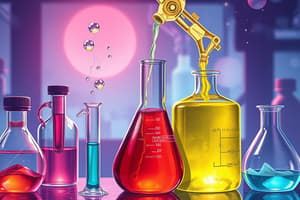Podcast
Questions and Answers
This substance is a common indicator used for titration.
This substance is a common indicator used for titration.
- Endpoint
- Phenolphthalein (correct)
- Titrant
- Analyte
- Burette
- Sodium hydroxide
- Pipette
This is indicated by color change, signaling that the reaction between the titrant and analyte is complete.
This is indicated by color change, signaling that the reaction between the titrant and analyte is complete.
- Burette
- Pipette
- Phenolphthalein
- Endpoint (correct)
- Sodium hydroxide
- Analyte
- Titrant
This is the main laboratory apparatus used for titration.
This is the main laboratory apparatus used for titration.
- Titrant
- Analyte
- Burette (correct)
- Pipette
- Sodium hydroxide
- Endpoint
- Phenolphthalein
In titration, it is the substance whose concentration you are trying to determine.
In titration, it is the substance whose concentration you are trying to determine.
What is the purpose of an indicator in a titration?
What is the purpose of an indicator in a titration?
What is the main difference between the titrant and the analyte in a titration?
What is the main difference between the titrant and the analyte in a titration?
What is the significance of endpoint in a titration?
What is the significance of endpoint in a titration?
The __________ is the solution of known concentration added during titration.
The __________ is the solution of known concentration added during titration.
A __________ is the chemical substance whose concentration is unknown and is being analyzed.
A __________ is the chemical substance whose concentration is unknown and is being analyzed.
The __________ is used to visually indicate the completion of a titration by changing color.
The __________ is used to visually indicate the completion of a titration by changing color.
The __________ is the specific point during titration where the indicator changes color.
The __________ is the specific point during titration where the indicator changes color.
In titration, a common indicator used is __________.
In titration, a common indicator used is __________.
The main laboratory apparatus for performing titrations is the __________.
The main laboratory apparatus for performing titrations is the __________.
A __________ is often used in simple acid-base titrations to hold the solution being analyzed.
A __________ is often used in simple acid-base titrations to hold the solution being analyzed.
The careful __________ of titrant to analyte is crucial for accurate titration results.
The careful __________ of titrant to analyte is crucial for accurate titration results.
In titration, the solution of known concentration is called the ______.
In titration, the solution of known concentration is called the ______.
The substance being analyzed in a titration is referred to as the ______.
The substance being analyzed in a titration is referred to as the ______.
An ______ is a point in titration where the color change occurs, indicating the reaction is complete.
An ______ is a point in titration where the color change occurs, indicating the reaction is complete.
To visually identify the endpoint in a titration, a ______ is used.
To visually identify the endpoint in a titration, a ______ is used.
A ______ is the main laboratory apparatus utilized during titration to dispense the titrant.
A ______ is the main laboratory apparatus utilized during titration to dispense the titrant.
Flashcards
Titration
Titration
A technique used to determine the exact concentration of an unknown solution by reacting it with a solution of known concentration. One solution is slowly added to the other until a chemical reaction is complete, which is indicated by a color change.
Titrant
Titrant
The solution of known concentration that is carefully added to the analyte during titration.
Analyte
Analyte
The solution of unknown concentration that is being analyzed during titration.
Indicator
Indicator
Signup and view all the flashcards
Endpoint
Endpoint
Signup and view all the flashcards
Burette
Burette
Signup and view all the flashcards
Pipette
Pipette
Signup and view all the flashcards
Phenolphthalein
Phenolphthalein
Signup and view all the flashcards
Acid-Base Titration
Acid-Base Titration
Signup and view all the flashcards
What is the titrant?
What is the titrant?
Signup and view all the flashcards
What is the analyte?
What is the analyte?
Signup and view all the flashcards
What is the indicator?
What is the indicator?
Signup and view all the flashcards
What is the endpoint?
What is the endpoint?
Signup and view all the flashcards
What is the burette?
What is the burette?
Signup and view all the flashcards
What is titration?
What is titration?
Signup and view all the flashcards
What is a titrant?
What is a titrant?
Signup and view all the flashcards
What is an analyte?
What is an analyte?
Signup and view all the flashcards
What is an indicator in titration?
What is an indicator in titration?
Signup and view all the flashcards
What is the endpoint in titration?
What is the endpoint in titration?
Signup and view all the flashcards
What is a burette used for?
What is a burette used for?
Signup and view all the flashcards
What is a pipette?
What is a pipette?
Signup and view all the flashcards
What is phenolphthalein?
What is phenolphthalein?
Signup and view all the flashcards
Study Notes
Titration
- Titration is a chemical technique that involves slowly adding a solution of known concentration (titrant) to another solution of unknown concentration (analyte) until the reaction is complete.
- This helps determine the exact amount of the unknown substance in the solution.
Titration Apparatus
- Burette is the main laboratory apparatus used during titration.
- Stopcock (on burette): Controls the flow of liquid.
- Conical flask: Used to hold the analyte solution.
- White tile: Used as a background to observe color changes during titration.
- Buret clamp: Holds the burette in place.
Titration Components
- Analyte: The substance of unknown concentration being measured in the titration.
- Titrant: The solution with a known concentration, carefully added to the analyte during the titration.
- Indicator: A substance that changes color at the endpoint of titration, helping visually identify when the reaction in titration is complete. Examples include phenolphthalein, bromothymol blue, and methyl orange.
- Endpoint: The point in a titration where the indicator changes color, signaling the reaction between the titrant and analyte is complete.
Learning Competencies
- Define titration and its components.
- Identify laboratory apparatuses used during titration.
- Perform a simple acid-base mini-titration.
- Cultivate a sense of curiosity and inquiry about chemical reactions.
Pre-Assessment/Test Questions
- Common indicator for titration (e.g., phenolphthalein).
- Color change indicating reaction completion (visual indication with an indicator).
- Main laboratory apparatus used for titration (burette).
- Substance in titration whose concentration is unknown (analyte).
Studying That Suits You
Use AI to generate personalized quizzes and flashcards to suit your learning preferences.




